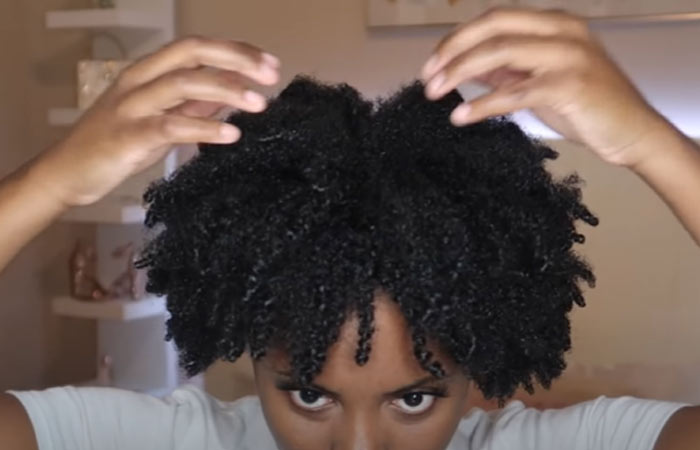These days, many tools in the market completely transform hair in just a few minutes. But most of these instruments operate on high heat that ultimately harms the hair. The damage comes from constantly being exposed to high temperatures, and that often changes the entire structure of hair. For curly-haired people, flat irons often make the hair look perfectly smooth, but at what cost?
4c hair is the most kinky of all the curly hair types, and when they get heat damage, the result is severe. The lack of moisture makes the damaged 4c hair look rough, dry, and brittle.
But can that kind of hair be repaired? In this article, we discuss all about heat damage and the steps that you can take to lessen its effects.
Causes Of Damaged 4c Hair
Heat damage to the hair can be caused by a lot of factors. But the most common reason is hair styling tools. From hair driers to straighteners and curling rods, all of them change the hair’s shape with extreme heat. When we use these electronics at the highest settings frequently, hair gets frazzled and damaged.

The heat from these devices, which are often written to be at 400°F, destroys the protein keratin in the strands. Another way your hair can get heat damaged is from the hot rays of the sun. The harmful ultraviolet rays affect hair quality if you stay under direct sunlight for a long time.
Levels of Heat Damage
Hair of every kind can get heat damaged, be it ramrod straight or tight ringlets. However, different levels of heat damage can be found by examining the hair strands. The first and least affected hair is a little less shiny than ordinary hair. It is also a little thinner near the ends due to the lifted cuticles.
When hair gets gradually more damaged, there are aberrations on the cuticle, which leads to the cortex being exposed. In damaged 4c hair, you can feel the change in the drastic difference as the cortex becomes vulnerable.
But the most extreme level of heat damage is when parts of the cuticle may be completely missing.
Signs of Damaged 4C Hair
1. Excessive Shedding

The first sign of heat damage to look out for would be excessive hairfall. We all face hairfall every day, and as per statistics, the average person loses 50-100 hairs every day. But if you see a number far more than that, consider that your hair may be suffering from heat-induced problems.
2. Excessive Dryness

One of the most common hair tools that contribute significantly to heat-damaged 4c hair are hair drier. The heat that makes the hair dry after shampooing also dies it out further due to continuous use. Yes, wet hair is vulnerable to breakage, but overusing hair dryers would drain all the moisture in your hair from within.
3. No Elasticity

Another characteristic of curly hair that gets severely damaged when subjected to continuous heat is elasticity. Your natural 4c hair is rich in moisture, so when you pull at the ringlets, they elongate. But when you let go of the strands, they jump back to their original curly shape. But heat-damaged hair loses its elasticity and just breaks off when pulled from the roots.
4. Porous Hair

Among the layers of hair, the topmost layer is the cuticle, and it determines how much oil and water passes through. The ability of hair strands to retain moisture depends on how porous they are. So, if your hair is highly damaged, the cuticles will be destroyed, and unwanted pollutants will pass through.
5. Lots of Tangles

If you find that your once silky soft hair has now become a tangled mess, you can be sure it’s damaged. As the strands dry out, they lose their elasticity and become a mess. Tangled hair also breaks a lot easier than the smoother strands. With damaged hair, you are sure to have a problem brushing away the knots and keeping them neat.
6. Wrong Hair Color

When hair is damaged, it loses a lot of its original structure. It becomes dry and loses its shine, elasticity, and porosity. But if you are prone to coloring, you will find a stark difference in the result. Healthy hair looks very different from damaged hair, which absorbs excessive color.
7. Lack of Curls

4c hair is known for its intense curls. But one of the most significant ways in which heat affects the hair is that it loses its curly nature. Continuous use of heated tools will slowly loosen the curly strands until they finally disappear. In the final stages of heat damage, the hair becomes completely devoid of its unique ringlets.
8. Split Ends

Hair grows healthy from the roots, where it gets plenty of nutrients from the sebum glands. But as hair elongates, the strands get too little sustenance to protect them, resulting in split ends. This becomes especially bad when heat is involved, as it exposes the strands and makes them split faster.
Prevention of Heat-Damaged 4C Hair
Avoid Electronics Like Straightners
The best way to keep your hair safe from heat damage is not to use heated tools. Hair driers and curlers might give you a picture-perfect hair day, but in the long run, it destroys the strands. If you were to air-dry your hair instead of using a blower, you would find that enough moisture is retained. That way, the strands won’t get dehydrated as you step out.

Heat damage also occurs when you use tools sparsely but at high frequencies. So, if you have damaged 4c hair, use blowers on the lowest setting. It might take more time to dry, but it is faster than air drying and less harmful in the end.
Use Heat-Protective Products
Another undeniable way to prevent hair damage is using heat protection spray before styling. With the right products, even with regular styling, your hair will not become as damaged. The heat-protective sprays available in the market are infused with several beneficial elements that withstand up to 450 degrees.

Another way to protect your strands from the environment is the use of sun-protecting sprays. These protect your hair from the harmful ultraviolet rays of the sun and keep it from getting dry. Using these before a day out will give you shiny, healthy hair without a mess.
Is Heat Damage Irreversible?
It is true when people say that highly damaged hair is irreversible. The heat completely changes the mair’s morphology, even altering the protein bonds of the strands. The keratin in each strand is curved, making an alpha helix that is even present in straight hairs. When you heat hair to about 400 degrees, the helix starts melting.

The structure of damaged 4c hair changes from curls to frizzy because of the destruction of the helix. The hair beyond the follicles is made of dead cells, so they do not regenerate their original structure. Once destroyed, the hair will not go back to its original self.
But always remember that the damage cannot be done in one use. You will not irrevocably destroy your hair by straightening it once. Prolonged and continuous use with any kind of protection destroys the bonds. And little damage can be repaired with some careful steps to heal the bonds.
How to Repair Damaged 4c Hair
If your hair is not severely damaged, it is possible to reverse some of the characteristics. Here are some ways you can start the healing process.
1. Build the Ideal Routine
The first thing you must do after ditching the heating tools is take a good, hard look at your haircare regime. A lot of the heat damage can be rectified by using the right products. Curly hair also needs special products to make sure the curls look fresh and bouncy. So, instead of your regular products, get shampoos and conditioners that help with curls.
Damaged 4c hair also lacks protein and moisture, so choose products that moisturize deeply.

Step 1: The first thing you do before styling your hair is shampoo. And going back to healthy curls also starts with this process of cleansing. Co-washing is well and good, but a clarifying shampoo is necessary to remove the buildup of sprays. The shampoo is supposed to remove the moisture blockers and make sure water enters the strands.
Step 2: The next product your hair needs is a reconstructor. The usual heated tools damage the cuticles of your hair, so you need something that repairs the bond. There are many products available in the market that work from within and strengthen the structure of the protein helix.
One of the most popular active ingredients to look out for would be Bis-Aminopropyl Diglycol Dimaleate. This restores the hair to its original shape, much like how broken bones are mended with casts. Products like these must be applied to each strand, so work in sections.
Step 3: An integral part of restoring damaged 4c hair to its natural curls is moisture. So, a hydrating conditioner is invaluable to haircare. The kinky hair types like 4c are also quite difficult to untangle and remade into curls. And a cleansing followed by deep conditioning is a must.
When curly hair is constantly blow-dried or flat ironed, moisture is lost, and the hair becomes brittle. But with a good conditioner, you can slowly build up the moisture and see the curls coming back to life. Make sure to keep on the creamy conditioners anywhere from 30 minutes to 1 hour for optimum results.
Step 4: The last step is a hot oil treatment, where hair is massaged with a warm concoction of beneficial oils. These, along with the deep conditioning, will help the strands regain their shine and elasticity, making them shine. For best results, oil throughout the scalp and the entire length of hair before wrapping it with saran wrap. The heat from your head will help the oils penetrate better and faster.
2. Avoid Chemical Treatments
Heat-damaged hair is already at its worst state. But one thing that would heal the remaining curls would be leaving them untouched for the time being, And that means no chemical treatments like dyes.

The chemicals present tend to worsen hair quality, so ceasing all treatments is the best way to go.
3. Trim or Cut if Needed
The last resort to saving your heat-damaged hair would be cutting it all off. This is undoubtedly the fastest and most efficient way of healing your hair. As new hair grows from the follicles, they will be healthy, and you will have your curls back. This might be a little painful, as it means giving up on your long curls. But in the end, the fresh ringlets are worth it.

If you do not want to let go of all of your hair, you can also trim off the jagged ends. These are often the most damaged section of your strands, as they have little to no nutrients left. Hair grows at different paces, but you can have a monthly trim of ½ inches to keep split ends at bay. For highly damaged 4c hair, you need to assess the strands and make the necessary cut.
Bottom Line
4c hair is beautiful when styled, whether it be in ringlets or its original kinky fashion. But so many of the tools used to transform hair use heat of the highest settings. This head leads to the hair getting severely damaged to the point of no recognition. Some believe that once damaged, hair cannot go back to its healthy self, but that is simply untrue.
By understanding the real causes of heat damage, you can take precautions to keep your hair healthy. But damaged 4c hair can be repaired as well; you just need a carefully planned out routine.
And don’t forget to let us know about your take on heat-damaged hair in the comments!





